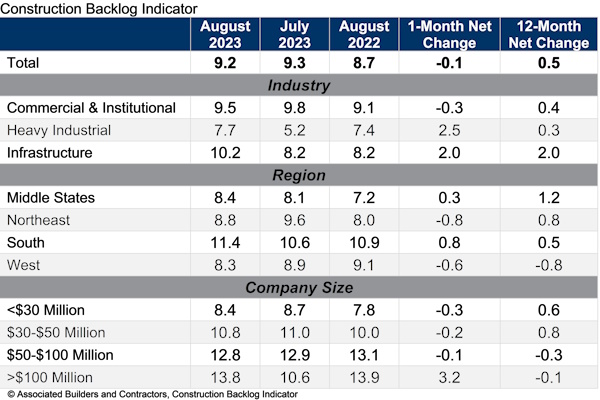Associated Builders and Contractors' Construction Backlog Indicator declined to 9.2 months in August, down 0.1 month, according to an ABC member survey conducted from Aug. 21 to Sept. 6. The reading is 0.5 months above the August 2022 level.
Backlog decreased on a monthly basis for all categories of company size except for those with more than $100 million in annual revenues, while only the smallest two revenue categories have higher backlog than in August 2022.
ABC’s Construction Confidence Index reading for sales, profit margins and staffing levels moved higher in August. All three readings remain above the threshold of 50, indicating expectations of growth over the next six months.
“There’s no sign of a construction recession in the near term,” said ABC Chief Economist Anirban Basu. “If anything, contractors are more upbeat, as policy and technology shifts along with economic transformation, are creating substantial demand for improvements and growth in America’s built environment.
“While a plurality of contractors expects only small improvements in sales, profit margins and staffing over the next six months, even incremental improvement is remarkable in the context of tightening credit, higher project financing costs and lingering fears of recession,” said Basu. “Backlog continues to be at the upper end of historic levels, with the infrastructure category registering substantial gains in backlog in August. That suggests that a growing number of public works projects is poised to break ground.”


Related Stories
| Feb 8, 2013
Modest growth predicted for engineering, construction mergers
Small and mid-market deals and construction materials drive activity; U.S. is the most active individual nation.
| Feb 8, 2013
FMI/CURT 2012 Owner Study highlights construction industry challenges
Capital program owners grapple with concerns about project funding, staffing, regulations.
| Feb 6, 2013
RSMeans cost comparisons: office buildings and medical offices
RSMeans' February 2013 Cost Comparison Report breaks down the average construction costs per square foot for four types of office buildings across 25 metro markets.
| Feb 6, 2013
Arcadia (Calif.) High School opens $20 million performing arts center
A 60-year old wish for the community of Arcadia has finally come true with the opening of Arcadia Unified School District’s new $20 million Performing Arts Center.
| Jan 31, 2013
The Opus Group completes construction of corporate HQ for Church & Dwight Co.
The Opus Group announced today the completion of construction on a new 250,000-square-foot corporate headquarter campus for Church & Dwight Co., Inc., in Ewing Township, near Princeton, N.J.
| Jan 31, 2013
Map of U.S. illustrates planning times for commercial construction
Stephen Oliner, a UCLA professor doing research for the Federal Reserve Board, has made the first-ever estimate of planning times for commercial construction across the United States.
| Jan 29, 2013
Tutor Perini Corp. to Implement Textura Prequalification Management Companywide
Rollout across the Tutor Perini organization will enhance the subcontractor prequalification experience and enable a standardized process in support of the contractor default insurance program.















